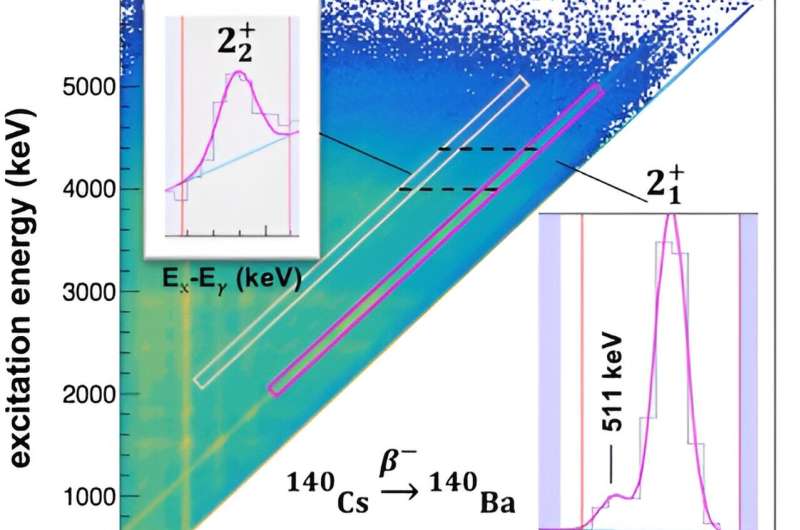
September 12, 2024 by Lea E. Radick, Argonne National Laboratory
Collected at: https://phys.org/news/2024-09-experimental-unravel-mystery-creation-heavy.html
How are stars born, and how do they die? How do they produce the energy that keeps them burning for billions of years? How do they create the elements we observe today? Definitive answers to these questions continue to elude scientists in their quest to understand the processes that shape the chemical makeup of the universe.
Although the exact details of the reaction processes are unclear, understanding where and how elements are formed, and the processes of star formation, is essential for a comprehensive picture of the universe’s history, structure and evolution.
Recently, an international team, including researchers from the U.S. Department of Energy’s (DOE) Argonne National Laboratory, obtained new experimental data that clarifies how some of the heaviest elements in the universe are formed in stars. This discovery begins to answer fundamental questions about our origins.
The findings are published in the journal Physical Review Letters.
In particular, the team obtained the first experimental constraints for measuring the rate of the process in which neutrons collide and merge with a nucleus of the isotope barium-139 to form barium-140. Isotopes are members of a family of an element that all have the same number of protons but different numbers of neutrons. The reaction rate of barium-139 as it turns into barium-140 has been a dominant source of uncertainty in predictive models used to determine the presence of isotopes of heavy elements in stars.
Led by Artemis Spyrou, a professor in the Department of Physics and Astronomy at Michigan State University and the Facility for Rare Isotope Beams (FRIB), and Dennis Mücher, a professor at the Institute for Nuclear Physics at the University of Cologne, Germany, the team benefited from the use of CARIBU, a sophisticated source of radioactive ions located at the Argonne Tandem Linac Accelerator System (ATLAS), a DOE Office of Nuclear Physics user facility at Argonne.
“It is now clear that the synthesis of elements in stars is more complex than previously thought,” said Spyrou. “Only through this type of measurement will we be able to disentangle the contributions from different astrophysical processes.”
Scientists have known for a long time that the heavy elements in stars, such as barium, lanthanum and cesium, are created through rapid and slow nucleosynthesis processes. Nucleosynthesis is the formation of new atomic nuclei—the centers of atoms that are made up of protons and neutrons—or elements, by various processes in the universe.
The rapid or “r” process, which takes place in a matter of seconds, is thought to be responsible for nucleosynthesis in exploding stars, such as supernovae, and the small, dense stars that emerge after their collapse. Conversely, the slow or “s” process is thought to be responsible for nucleosynthesis primarily in brightly burning older stars, nearing the end of life.
Relatively new astronomical observations point to a nucleosynthesis pathway different from the rapid and slow processes. As some stars thought to be poor in metal have shown unusual abundance patterns of certain elements, scientists proposed an intermediate or “i” process to explain this phenomenon.
“What is most fascinating to me is that we find these different elements here on Earth, and often without knowing it, interact with them almost daily,” said Mücher. “However, we still don’t fully understand where they come from. Now, we have a better understanding that the i process is somehow related.”
Enabled by the CARIBU source at ATLAS, scientists have been able to study barium isotopes as they captured neutrons and eventually formed lanthanum—a byproduct of barium-139 decay—and a key indicator of the i process. However, determining this neutron-capture rate is especially challenging because the half-life of barium-139 is only 83 minutes.
With the aid of certain experimental techniques, researchers have found it is possible to indirectly determine this rate with a beam of the isotope cesium-140. This isotope undergoes radioactive decay into barium-140 and in doing so, emits a gamma ray, which researchers were able to detect and measure using FRIB’s Summing Nal (SuN) detector, a total absorption gamma-ray spectrometer. By more accurately capturing data for this process, researchers could indirectly calculate the reaction rate of barium-139 as it turns into barium-140, and the probability that this reaction will produce lanthanum.
“The technique that is being used requires radioactive beams of both fairly high intensity and very high purity,” said ATLAS director Guy Savard, an Argonne Distinguished Fellow. “CARIBU provides these conditions for a whole range of neutron-rich isotopes.”
Equipped with this newfound knowledge, researchers can apply what they’ve discovered in this study to other use cases at CARIBU and its near-future upgrade, nuCARIBU. There, they can further their understanding of how neutron capture works for neutron-rich isotopes in the i process. Eventually, they hope to find a more direct way to study the process.
“In the fall we’ll have a large experimental campaign enabled by nuCARIBU, making a number of measurements again, so we can expand the range over which this technique is applied, and look at many cases and try to understand the systematics of how this neutron capture on the neutron-rich isotopes works,” said Savard. “This is just the first step,” he added.
In addition to Spyrou, Mücher and Savard, authors include P.A. Denissenkov, F. Herwig, E.C. Good, G. Balk, H.C. Berg, D.L. Bleuel, J.A. Clark, C. Dembski, P.A. DeYoung, B. Greaves, M. Guttormsen, C. Harris, A.C. Larsen, S.N. Liddick, S. Lyons, M. Markova, M.J. Mogannam, S. Nikas, J. Owens-Fryar, A. Palmisano-Kyle, G. Perdikakis, F. Pogliano, M. Quintieri, A.L. Richard, D. Santiago-Gonzalez, M.K. Smith, A. Sweet, A. Tsantiri and M. Wiedeking.
More information: A. Spyrou et al, First Study of the 139Ba(n,γ)140Ba Reaction to Constrain the Conditions for the Astrophysical i Process, Physical Review Letters (2024). DOI: 10.1103/PhysRevLett.132.202701
Journal information: Physical Review Letters

Leave a Reply